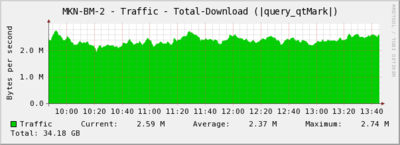Manual:SNMP: Difference between revisions
No edit summary |
|||
| Line 1: | Line 1: | ||
{{Versions|v5}} | {{Versions|v5}} | ||
__TOC__ | |||
Simple Network Management Protocol (SNMP) is an Internet-standard protocol for managing devices on IP networks. SNMP can be used to graph various data with tools such as CACTI, MRTG or [http://www.mikrotik.com/thedude.php The Dude] | Simple Network Management Protocol (SNMP) is an Internet-standard protocol for managing devices on IP networks. SNMP can be used to graph various data with tools such as CACTI, MRTG or [http://www.mikrotik.com/thedude.php The Dude] | ||
| Line 144: | Line 146: | ||
/system script run 0 | /system script run 0 | ||
</pre> | </pre> | ||
{{cont}} | |||
[[Category:Manual]] | [[Category:Manual]] | ||
[[Category:SNMP]] | [[Category:SNMP]] | ||
Revision as of 09:53, 8 December 2011
Simple Network Management Protocol (SNMP) is an Internet-standard protocol for managing devices on IP networks. SNMP can be used to graph various data with tools such as CACTI, MRTG or The Dude
Specifications
RouterOS supports SNMP v1,2 and 3. SNMP write is also supported.
Configuration
To enable SNMP in RouterOS:
[admin@MikroTik] /snmp> print
enabled: no
contact:
location:
engine-id:
trap-community: (unknown)
trap-version: 1
[admin@MikroTik] /snmp> set enabled yes
You can also specify administrative contact information in the above settings. All SNMP data will be available to communities configured under /snmp community.
Community

Warning: Default settings only have one community named public without any additional security settings. These settings should be considered insecure and has to adjusted according required security profile.
Management information base (MIB)
You can download the latest MikroTik RouterOS MIB file. RouterOS v5.x uses such MIBs:
- MIKROTIK-MIB
- MIB-2
- HOST-RESOURCES-MIB
- IF-MIB
- IP-MIB
- IP-FORWARD-MIB
- IPV6-MIB
- BRIDGE-MIB
- DHCP-SERVER-MIB
- CISCO-AAA-SESSION-MIB
- ENTITY-MIB
- UPS-MIB
- SQUID-MIB
Object identifiers (OID)
Each OID identifies a variable that can be read via SNMP. Although the MIB file contains all the needed OID values, you can also print individual OID information in the console with the print oid command at any menu level:
[admin@MikroTik] /interface> print oid
Flags: D - dynamic, X - disabled, R - running, S - slave
0 R name=.1.3.6.1.2.1.2.2.1.2.1 mtu=.1.3.6.1.2.1.2.2.1.4.1
mac-address=.1.3.6.1.2.1.2.2.1.6.1 admin-status=.1.3.6.1.2.1.2.2.1.7.1
oper-status=.1.3.6.1.2.1.2.2.1.8.1 bytes-in=.1.3.6.1.2.1.2.2.1.10.1
packets-in=.1.3.6.1.2.1.2.2.1.11.1 discards-in=.1.3.6.1.2.1.2.2.1.13.1
errors-in=.1.3.6.1.2.1.2.2.1.14.1 bytes-out=.1.3.6.1.2.1.2.2.1.16.1
packets-out=.1.3.6.1.2.1.2.2.1.17.1 discards-out=.1.3.6.1.2.1.2.2.1.19.1
errors-out=.1.3.6.1.2.1.2.2.1.20.1
Traps
SNMP write
Since RouterOS v3, SNMP write is supported for some functions. SNMP write allows to change router configuration with SNMP requests. Consider to secure access to router or to router's SNMP, when SNMP and write-access are enabled.
Writable options
To change settings by SNMP requests, use the command below to allow SNMP write for the selected community, Write-access option for SNMP is available from v3.14,
/snmp community set <number> write-access=yes
System Identity
It's possible to change router system identity by SNMP set command,
snmpset -c public -v 1 192.168.0.0 1.3.6.1.2.1.1.5.0 s New_Identity
- snmpset, SNMP application used for SNMP SET requests to set information on a network entity;
- public, router's community name;
- 192.168.0.0, IP address of the router;
- 1.3.6.1.2.1.1.5.0, SNMP value for router's identity;
SNMPset command above is equal to the RouterOS command,
/system identity set identity=New_Identity
Reboot
It's possible to reboot the router with SNMP set commamd, you need to set value for reboot SNMP settings, which is not equal to 0,
snmpset -c public -v 1 192.168.0.0 1.3.6.1.4.1.14988.1.1.7.1.0 s 1
- 1.3.6.1.4.1.14988.1.1.7.1.0, SNMP value for the router reboot;
- s 1, snmpset command to set value, value should not be equal to 0;
Reboot snmpset command is equal to the RouterOS command,
/system reboot
Run Script
SNMP write allows to run scripts on the router from system script menu, when you need to set value for SNMP setting of the script,
snmpset -c public -v 1 192.168.0.0 1.3.6.1.4.1.14988.1.1.8.1.1.3.X s 1
- X, script number, numeration starts from 1;
- s 1, snmpset command to set value, value should not be equal to 0;
The same command on RouterOS,
/system script> print Flags: I - invalid 0 name="kaka" owner="admin" policy=ftp,reboot,read,write,policy, test,winbox,password,sniff last-started=jan/01/1970 01:31:57 run-count=23 source=:beep /system script run 0
[ Top | Back to Content ]

